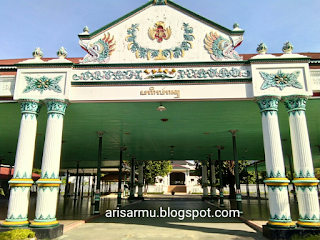Kraton is the King's Palace which some parts are open for public, and to maintain the existence of Javanese culture in Indonesia as well.
Yogyakarta Palace or Kraton Yogyakarta, officially known as Keraton Ngayogyakarta Hadiningrat, lies in the downtown area of Yogyakarya city.
The Palace was built by Prince Mangkubumi (before changing his title to Sultan Hamengkubuwono I) few months after the Treaty of Giyanti on February 13, 1755 which devided the Sultanate of Mataram became two parts, the eastern half was given to Pakubuwono III with Surakarta as its capital, while Prince Mangkubumi received the western half with Yogyakarta as its capital.
Visiting kraton, although you can not expect much, at least, it represents the life of Javanese people in the past and preserve its culture.
Kraton Yogyakarta
Location
Downtown area of Yogyakarta City, Yogyakarta Special Region, Indonesia
Opening Hours
Daily 08.30 am - 03.00 pm
Entrance Fee
Local tourist IDR 5,000
Foreign tourist IDR 7,000
Batik course near Kraton Yogyakarta
Learning how to make Batik is absolutely exquisite experience that pity to be ignored.
Here in "kampung" Rotowijayan, merely 5 minutes walk from Kraton Yogyakarta (Yogyakarta Palace), afford you with batik lesson as well as take your own creation home, definitely as a valuable gift from your holiday.
Kampung (residential area) Rotowijayan, part of kraton area, is renowned as "kampung abdi dalam" or a royal servant residential area from the offspring of "Sais Kereta Kencana" (a Royal Chariot Coachman).
Abdi dalem is a person who dedicates himself to a Sultan (a King) with a low salary, for ministering is the main purpose. And one of his chore is to maintain the properties of kraton.
There is an unnamed gallery inside this complex, opens daily from 9 am to 5 pm, which has been serving to preserve batik art since the reign of Sultan Hamengkubuwono IX (king of Yogyakarta).
Batik, appointed by Unesco as a Masterpiece of Oral and Intangible Heritage of Humanity, is a tradition Indonesian art of wax-resist dyeing applied to a cloth. And the patterns are varied depend on a variety of culture influences.
If you are interested to learn batik, the course fee is at IDR 200k per day, and this gallery also sells batik painting for IDR 200k to 4,000k/each, said Agus the chairman.
 |
| an alley to "kampung abdi dalem" Rotowijayan |




